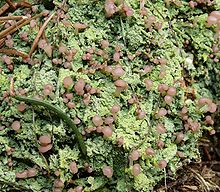Baeomyces
| Baeomyces | |
|---|---|

| |
| Baeomyces rufus | |
| Scientific classification | |
| Domain: | Eukaryota |
| Kingdom: | Fungi |
| Division: | Ascomycota |
| Class: | Lecanoromycetes |
| Order: | Baeomycetales |
| Family: | Baeomycetaceae |
| Genus: | Baeomyces Pers. (1794) |
| Type species | |
| Baeomyces byssoides | |
| Species | |
|
B. byssoides | |
| Synonyms[1] | |
Baeomyces is a genus of lichenized fungi in the family Baeomycetaceae.[2] Members of Baeomyces are commonly called cap lichens.[3][4] The genus was circumscribed by German mycologist Christiaan Hendrik Persoon in 1794.[5] Although Persoon did not designate a type species in his original description of the genus, Frederick Clements and Cornelius Lott Shear assigned Baeomyces byssoides as the type in 1931.[6]
Species[edit]
As of October 2022[update], Species Fungorum (in the Catalogue of Life) accepts 6 species of Baeomyces.[7]
- Baeomyces byssoides (L.) P.Gaertn., B.Mey. & Scherb. (1802)
- Baeomyces carneus Flörke (1821)
- Baeomyces heteromorphus Nyl. ex C.Bab. & Mitt. (1859)
- Baeomyces lotiformis S.N.Cao (2017)[8] – China
- Baeomyces placophyllus Ach. (1803)
- Baeomyces rufus (Huds.) Rebent. (1804)
References[edit]
- ^ "Synonymy. Current Name: Baeomyces Pers., Ann. Bot. (Usteri) 7: 19 (1794)". Species Fungorum. Retrieved 14 October 2022.
- ^ Wijayawardene, N.N.; Hyde, K.D.; Dai, D.Q.; Sánchez-García, M.; Goto, B.T.; Saxena, R.K.; et al. (2022). "Outline of Fungi and fungus-like taxa – 2021". Mycosphere. 13 (1): 53–453. doi:10.5943/mycosphere/13/1/2. hdl:10481/76378. S2CID 249054641.
- ^ USDA Natural Resources Conservation Service Name Search
- ^ Cap Lichen (Baeomyces), Encyclopedia of Life
- ^ Persoon, C.H. (1794). "Einige Bemerkungen über die Flechten". Annalen der Botanik (Usteri) (in German). 7: 1–32 [19].
- ^ "Record Details: Baeomyces Pers., Ann. Bot. (Usteri) 7: 19 (1794)". Index Fungorum. Retrieved 14 October 2022.
- ^ Source dataset. Species Fungorum Plus: Species Fungorum for CoL+. "Baeomyces". Catalog of Life Version 2022-09-25. Retrieved 14 October 2022.
- ^ Cao, Shunan; He, Jianfeng; Zhang, Fang; Tian, Huimin; Liu, Chuanpeng; Wang, Haiying; Zhou, Qiming (January 2018). "Baeomyces lotiformis sp. nov. from China". Mycotaxon. 132 (4): 831–837. doi:10.5248/132.831.
